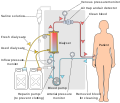Hemodialysis: Difference between revisions
CSV import Tags: mobile edit mobile web edit |
CSV import |
||
| Line 29: | Line 29: | ||
{{stub}} | {{stub}} | ||
<gallery> | |||
File:Hemodialysismachine.jpg|Hemodialysis machine | |||
File:Plugged into dialysis.jpg|Plugged into dialysis | |||
File:Semipermeable membrane (svg).svg|Semipermeable membrane | |||
File:Permacath.jpg|Permacath | |||
File:Patient lying in bed in intensive care unit of hospital with apparatuses and hemodialysis machine.jpg|Patient in intensive care with hemodialysis machine | |||
File:Hemodialysis-en.svg|Hemodialysis diagram | |||
File:CentralDialysatedelivery.JPG|Central dialysate delivery | |||
</gallery> | |||
Latest revision as of 01:37, 20 February 2025
Hemodialysis is a medical procedure used to remove waste and excess fluid from the blood when the kidneys are not able to adequately do so. It is one of the most common treatments for advanced, end-stage kidney disease.
Overview[edit]
Hemodialysis involves circulating the patient's blood outside of the body through a machine known as a dialyzer or artificial kidney. The dialyzer has two parts: one for the patient's blood and another for a wash fluid known as dialysate. A thin membrane separates these two parts. Blood cells, protein and other important blood components are too large to pass through the membrane, but waste products and excess fluid move from the blood to the dialysate.
Procedure[edit]
Before starting hemodialysis, the patient needs a vascular access, which is a way to reach the patient's bloodstream. There are three types of vascular access: arteriovenous (AV) fistula, AV graft, and venous catheter.
During hemodialysis, the patient's blood is pumped through soft tubes to the dialyzer. The dialyzer removes waste and extra chemicals and fluid from the blood. Then the cleaned blood flows through another set of tubes and back into the body.
Risks and Complications[edit]
Like any medical procedure, hemodialysis has potential risks and complications. These can include low blood pressure, anemia, bone diseases, high blood pressure, heart disease, nerve damage, infection, and blockage or clotting of the vascular access.
Alternatives[edit]
Alternatives to hemodialysis include peritoneal dialysis and kidney transplant. The choice of treatment depends on the patient's health condition, lifestyle, and personal preference.









